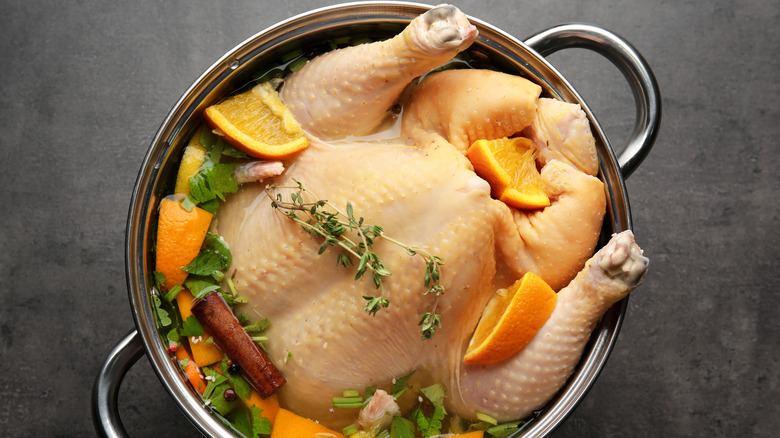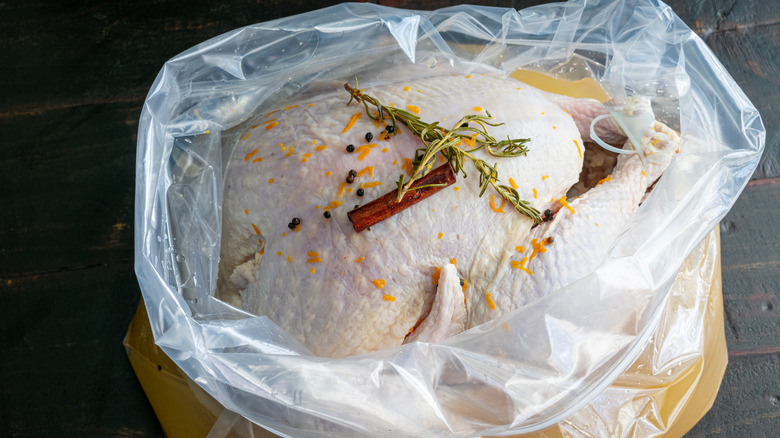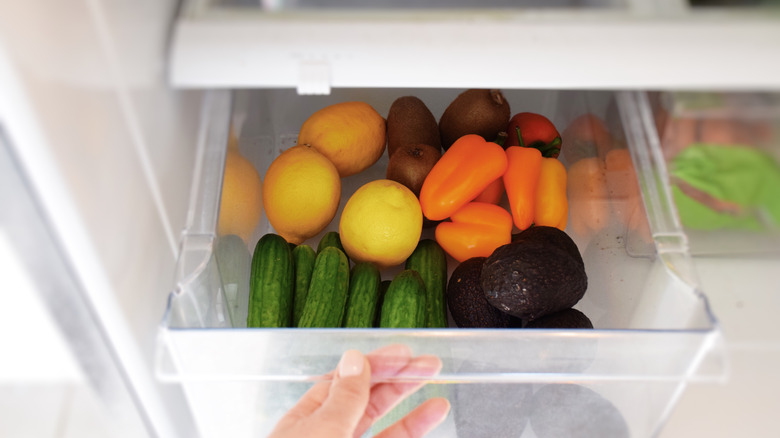Your Refrigerator Crisper Drawers Are Perfect For Brining Large Cuts Of Meat
To be a great home cook, it's not enough to master techniques and recipes; you've also got to have total command over the available space in your kitchen: Eliminating waste by cooking the fresh food you have available, diligently rotating stock by tossing and replacing pantry items whose freshness date has expired, and — perhaps most crucially — utilizing your refrigerator space to the fullest possible extent. This delicate balance is often threatened by needing an entire shelf to brine (or marinate) large cuts of meat. No longer — by using your fridge's crisper drawer as a brining bin, you can brine or marinate the big boys while still observing food safety protocols.
If you already know the joys of Cuban lechón asado — or roasted fresh ham marinated in sour orange juice and aromatics — the crisper drawer is the perfect place to put that big guy down to marinate. It's an elegant solution to a crying need: Crisper drawers are often underutilized, probably less-than-periodically cleaned, and tend to be the right size to hold large cuts of meat like a whole turkey or fresh ham. You'll need a drawer that's higher than eight inches to comfortably hold an entire turkey; luckily, a ton of refrigerator makes and models offer this drawer size. Beyond that, even smaller-sized drawers (typically around six inches high) are plenty big enough to brine a whole chicken or hold a Boston butt while it relaxes after a good dry rub.
Brining, not crisping
First and foremost, always observe safe food handling protocols. For processes involving large cuts of meat (brining chicken for frying can be a 12-hour process while brining a turkey can take up to 24), you must keep the food out of the USDA's so-called "danger zone" — the range of temperatures between 40 and 140 degrees Fahrenheit. This is the prime bacteria-growing temperature (including all the nasties that can cause sometimes fatal food-borne illnesses), and those bugs can double their number in at least 20 minutes. So, your refrigerator is the only place to do this work.
The second thing you'll need to brine in the crisper drawer (besides an appropriately sized, freshly-cleaned drawer) is what's known as a brining bag. This is sure to come as good news for those of us who've previously brined our turkeys in space-gobbling stock pots covered in plastic wrap. Brining bags are large, BPA-free, food-grade (for goodness' sake, never use garbage bags) reinforced plastic bags that often sport a double-track zipper to keep the meat and brine securely in place. The only thing you'll need to do is choose a bag large enough to submerge the fresh ham or turkey (or, alternatively, flip the cut halfway through the brining process).
Last but certainly not least
As mentioned, crisper drawers can hold large cuts of meat, whether you're brining or marinating. (Here's the rule: If you want juiciness, brine. If you want flavor, marinate.) What kind of brines should you consider? If you plan on smoking a beef brisket, consider an apple cider brine with salt, sugar, bay leaves, and black peppercorns. Whole chickens love more aromatic brines, say with dried sage and basil, garlic cloves, and slices of fresh lemon. And remember: The best beef bourguignon begins with a boneless braising cut immersed in a hearty marinade of French pinot noir, carrots, mushrooms, onion, garlic, bay leaves, and a bouquet garni.
Remember: Even if you didn't spill a drop of brine or marinade (something you should never assume anyway), it's essential that you clean and disinfect the crisper drawer thoroughly before returning it to its fridge-y home and customizing its settings to get the most out of your produce. If your drawer isn't dishwasher safe, a little antibacterial soap and some elbow grease should do just fine — but be sure to dry it first. These things are sensitive to humidity, you know.


